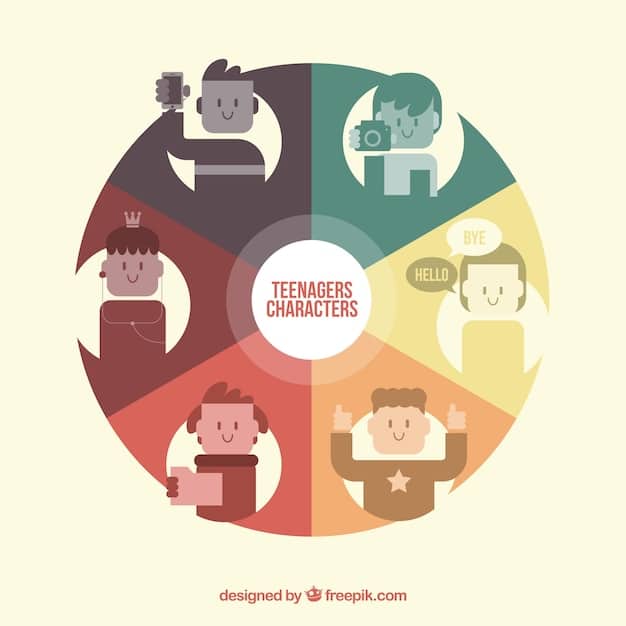The Evolution of K-Pop Fandom in the US: Demographics and Engagement

The evolution of K-Pop fandom in the US reflects changing demographics and engagement trends, driven by social media, diverse representation, and innovative digital content.
The evolution of K-Pop fandom in the US: a look at changing demographics and engagement trends reveals a fascinating story of cultural exchange, digital innovation, and community building.
The Early Days of K-Pop in America
The initial introduction of K-Pop to the US market was characterized by niche appeal and limited accessibility. Early fans often discovered K-Pop through online forums and file-sharing networks, where they pieced together information and built communities.
First Wave Artists
Artists like BoA and Rain made early inroads into the US market, although their success was limited. These pioneering efforts laid the groundwork for future generations of K-Pop artists.
Online Communities
Before social media became ubiquitous, online communities were essential for K-Pop fans to connect and share their passion. These forums fostered a sense of belonging and provided a platform for fans to organize events and campaigns.
Early K-Pop fandom in the US was driven by dedicated individuals who sought out niche content. These fans formed tight-knit communities and paved the way for the genre’s later expansion.
The Explosion of Social Media
The advent of social media platforms revolutionized K-Pop fandom by providing unprecedented access to artists and content as well as direct engagement with fans.
Twitter and Fan Campaigns
Twitter became a key platform for organizing fan campaigns, trending hashtags, and coordinating streaming goals. Fans leveraged Twitter to amplify K-Pop content and support their favorite artists.
YouTube and Content Accessibility
YouTube democratized access to K-Pop music videos, behind-the-scenes content, and variety shows. This accessibility allowed K-Pop to reach a wider audience and attract new fans.
- Social media allows real-time interactions between artists and fans.
- Fan campaigns can greatly increase visibility for K-Pop groups.
- YouTube’s accessibility helped spread K-Pop across the globe.
- Social media helps fans from different backgrounds connect.
Social media has significantly democratized K-Pop fandom. Twitter and YouTube are essential in creating engaging content and boosting group visibility.
Changing Demographics
The demographic makeup of K-Pop fandom in the US has become increasingly diverse, reflecting the wider cultural integration of the genre.

Increased Representation
K-Pop’s appeal extends beyond Asian American communities. More people from different ethnic and racial groups are also becoming K-Pop fans.
Younger Generations
Millennials and Gen Z have been instrumental in driving the growth of K-Pop fandom. Younger generations are more open to exploring global music and culture.
The US K-Pop fandom is diverse and inclusive. As younger generations become more open to the music genre, K-Pop’s fanbase continues to grow.
Engagement Trends
Engagement trends within K-Pop fandom have evolved beyond simple music consumption to encompass various forms of participatory culture.
Streaming and Chart Manipulation
Fans actively participate in streaming music to influence music charts. They work together to boost their favorite artists’ chart performance.
Merchandise and Collectibles
K-Pop fans frequently purchase merchandise and collectibles to show their support. The sales of fan-based items generate significant revenue for artists and labels.
Fan-Made Content
Fan-made content, including fan fiction, fan art, and reaction videos, have become integral aspects of K-Pop fandom. Such activities promote creativity and group participation.
- Streaming to manipulate music show charts has become common.
- Purchasing merchandise shows support for favorite artists.
- Fan-made content adds value and builds a stronger community.
- Fans gather to create meaningful relationships.
Engagement trends show that active participation is essential for the K-Pop community. Fans not only consume the music, but actively shape the culture.
The Impact of COVID-19
The COVID-19 pandemic significantly impacted K-Pop fandom, leading to innovative ways of engaging with music and artists remotely that may influence the growth of engagement trends.

Virtual Concerts and Fan Meetings
Virtual concerts and fan meetings became popular during the pandemic. These options allowed fans to interact with artists from their homes.
Online Streaming Parties
Online streaming parties let fans come together to listen to music. These interactions were critical for maintaining a sense of community during times of isolation.
The COVID-19 pandemic altered how the community connects with one another. Virtual concerts became popular during the peak of at-home isolation.
The Future of K-Pop Fandom in the US
The future of K-Pop fandom in the US is likely to be shaped by technological advancements, evolving audience preferences, and sustained cultural exchange.
Continued Digital Innovation
Digital innovation will improve how fans interact with artists. It will become easier to make connections with one another as technology improves.
Global Collaborations
Collaborations between K-Pop artists and American musicians may expand the audience. Partnerships can introduce K-Pop to diverse fan bases.
- Better tech will help improve the bonds between artists and fans.
- Collaborations with Western artists have the potential to grow the fan base.
- Diverse representations will allow more people to connect to K-Pop.
- Inclusivity will become increasingly important to K-Pop.
The future of K-Pop fandom will depend heavily on a welcoming environment. With technology improving, expect more engagement between K-Pop groups and their fans.
| Key Point | Brief Description |
|---|---|
| 🎵 Social Media Growth | Social platforms amplified K-Pop’s reach through fan campaigns and accessible content. |
| 🌍 Demographic Shifts | K-Pop’s fandom in the US has grown more diverse, including more ethnic and racial groups. |
| 💻 Virtual Engagement | COVID-19 pushed fans towards virtual concerts and streaming parties. |
| 🤝 Future Collaborations | Collaborations with Western artists are expected to introduce K-Pop to larger audiences. |
K-Pop Fandom FAQs
▼
K-Pop started gaining a fanbase in the US through online forums and file-sharing. Small but dedicated communities built the foundation for larger followings to come.
▼
Social media made it easier for fans to connect, organize campaigns, and consume K-Pop content. Platforms like Twitter and YouTube allow real-time interactions.
▼
The K-Pop fan base in the US is diverse. The music is enjoyed by a wide array of ethnic and racial groups led by younger Millennials and Generation Z.
▼
COVID-19 pushed fans to embrace virtual concerts and online streaming. These events allowed K-Pop fans to maintain a sense of community throughout the pandemic.
▼
The future of K-Pop Fandom will adapt to new tech. Western artist collaborations are expected to grow the fan base, aided by an environment of diverse inclusivity.
Conclusion
In conclusion, the evolution of K-Pop fandom in the US: a look at changing demographics and engagement trends shows us rapid growth. It shows how cultural integration allows innovative means of connecting fans with K-Pop artists in a way that breaks down barriers.





